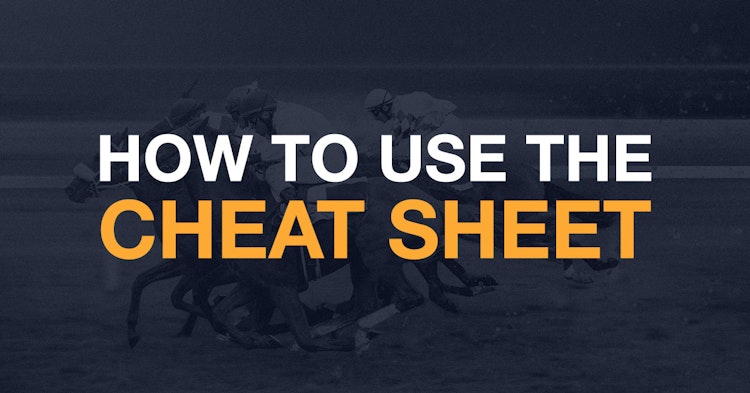Spring Carnival horse racing: How to use the Cheat Sheet
Last updated: Oct 24, 2019, 5:45AM | Published: Oct 22, 2019, 6:25AM
What is the racing Cheat Sheet? How does it work? What does it mean? How should I use it?
We know it's a little out of the box compared to what most punters are used to, so we've put together a 'Cheat Sheet 101' for punters to get the most out of the value selections during the Melbourne Cup and the rest of the Spring Racing Carnival.
GO STRAIGHT TO THE CHEAT SHEET
For more information on how the Cheat Sheet was built, you can read The Inside Guide: Cheat Sheet.
So here we go, a few facts that might not have been obvious the first time you saw Stats Insider's Cheat Sheet.
1. Our Cheat Sheet works differently to a standard 'tip sheet'
The Cheat Sheet displays runners our racing model has identified an 'edge' on - otherwise known as 'value' - by comparing our win probability against the current bookmakers' odds.
2. An 'edge' does not constitute a tip or a vote of confidence
Just because a runner has been identified having an 'edge', it doesn't mean our model is saying this horse is going to win their race. What it does show, is that our model thinks it is more likely to win than the bookies' current price... how much more likely is what you will see displayed in the 'edge' column onsite.

Research has shown betting on value selections (i.e where there is an ‘edge’ against the bookmakers) plays a key role in achieving long term success in the betting market.
3. Similar value doesn't mean similar win probabilities
There may be multiple runners on the Cheat Sheet with the same or similar value. This doesn't necessarily mean they have the same likelihood of winning their particular race. This is why we have separated our Cheat Sheet into segments: Hot Shots, Mid-Rangers, and Roughies.
A short-priced runner, or what we call a 'hot shot,' is generally going to be more likely to win their race than a 'mid-ranger' or a 'roughie'. This is what the odds are indicating.
Put very simply, the overarching theory is that long term, betting on runners with similar predicted 'value' should land you in the same position. However, if you bet on a ‘roughie’ you might have to wait longer for that winner to come home - but it will pay more when it does get up.
Similarly, ‘hot shots’ may win more often but won’t pay out as much when they do. It’s important to keep this in mind when reading through the Cheat Sheet.
4. Betting early may allow you to get on a runner before the value is soaked up by the market
Most bookmakers post their initial prices and then follow the betting trends as the race gets closer. This includes following sharp punters that are historically profitable when they bet closer to race time, and they use this to help wind-in the markets as/when relevant.
Betting earlier allows you to potentially get on a runner with an 'edge' before that value is soaked up by the betting market, however, when doing so you also run the risk that more information comes to light closer to race time, which may change the model’s projection of that particular runner.
5. The Cheat Sheet may be different each time you look at it
Our Cheat Sheet generally goes live for a meeting 20 hours before the first race jumps, allowing plenty of time for markets and odds to change between then and race start.
The Cheat Sheet follows the markets dynamically, updating every 10 minutes so when a horse drops off the Cheat Sheet, it may indicate that the odds have come in for this runner, meaning there may be less 'value' in that bet compared to at the previous price, or potentially new information has come to light (e.g a change in track conditions) resulting in a change in the models prediction.
Often when bookmakers wind in markets, it is because they believe this horse now has a greater chance of winning the race as opposed to their previous odds, so just because a runner drops off the Cheat Sheet it doesn't necessarily mean they are less likely to win, in fact in some cases, they may be more likely.
All it means is that the model is of the view they are no longer a value play at their current price.
You can see runners who have dropped off the Cheat Sheet by checking the "Show horses that previously had qualifying edges" filter. Below is an example of what the Cheat Sheet will look like when you select this option. 
6. What you do with the Cheat Sheet info is up to you
There is no such thing as a guaranteed win. As above, the fact a horse makes its way onto the Cheat Sheet should not be interpreted as a tip on that particular runner. The Cheat Sheet’s role is to break down the day's runners into the best value selections, according to our model's predictions and the current market price.
The Cheat Sheet is a great tool in analysing an edge when betting on horse racing long-term, and is best utilised in conjunction with our advanced form guide, your own knowledge, and whatever other information you may bring to the table. As always, please gamble responsibly this Spring Carnival Racing season.
For more info on the racing model and how it works, watch the video below.
Have some feedback for us? Leave a comment below, or join the conversation on the Stats Insider Twitter or Facebook page.



